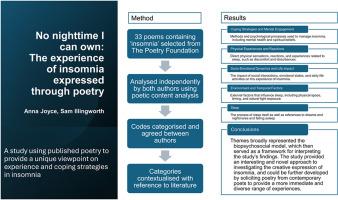No nighttime I can own: The experience of insomnia expressed through poetry
IF 3.4
2区 医学
Q1 CLINICAL NEUROLOGY
引用次数: 0
Abstract
Insomnia is a chronic sleep disorder associated with difficulty sleeping and a significant deleterious impact on daytime function and quality of life. This novel study investigates the experience of insomnia, and the impact and coping strategies expressed via the creative medium of poetry.
A total of 33 poems containing the word ‘insomnia’ were selected from The Poetry Foundation and analysed using poetic content analysis; a qualitative inductive technique that involved coding meaning units to the poetry, which were then categorised and agreed between the two authors.
The final agreed categories were: Coping Strategies and Mental Engagement, which reflected a range of standard and non-standard treatments and thoughts; Physical Experiences and Reactions, such as discomfort; Socio-Emotional Dynamics and Life Impact, such as emotional impact and relationships; Environment and Temporal Factors, including the sleeping area and house, and the passage of time; and Sleep, which included dreams and nightmares, and the lack thereof.
Themes broadly represented the biopsychosocial model, which then served as a framework for interpreting the study's findings. The study provided an interesting and novel approach to investigating the creative expression of insomnia, and could be further developed by soliciting poetry from contemporary poets to provide a more immediate and diverse range of experiences.

没有我能拥有的夜晚:通过诗歌表达的失眠体验。
失眠是一种慢性睡眠障碍,与睡眠困难有关,对白天的功能和生活质量有重大的有害影响。本研究探讨了失眠的经历,以及通过诗歌这一创作媒介所表达的影响和应对策略。从《诗学基础》中选取含有“失眠”一词的诗33首,采用诗歌内容分析法进行分析;一种定性归纳技术,涉及编码诗歌的意义单位,然后在两位作者之间进行分类和同意。最终商定的类别是:应对策略和心理参与,反映了一系列标准和非标准的治疗和想法;身体体验和反应,如不适;社会情绪动态和生活影响,如情绪影响和人际关系;环境和时间因素,包括睡觉的地方和房子,以及时间的流逝;睡眠,包括梦和噩梦,以及缺乏睡眠。主题广泛地代表了生物心理社会模型,然后作为解释研究结果的框架。这项研究为研究失眠的创造性表达提供了一种有趣而新颖的方法,并且可以通过征求当代诗人的诗歌来进一步发展,以提供更直接和多样化的体验。
本文章由计算机程序翻译,如有差异,请以英文原文为准。
求助全文
约1分钟内获得全文
求助全文
来源期刊

Sleep medicine
医学-临床神经学
CiteScore
8.40
自引率
6.20%
发文量
1060
审稿时长
49 days
期刊介绍:
Sleep Medicine aims to be a journal no one involved in clinical sleep medicine can do without.
A journal primarily focussing on the human aspects of sleep, integrating the various disciplines that are involved in sleep medicine: neurology, clinical neurophysiology, internal medicine (particularly pulmonology and cardiology), psychology, psychiatry, sleep technology, pediatrics, neurosurgery, otorhinolaryngology, and dentistry.
The journal publishes the following types of articles: Reviews (also intended as a way to bridge the gap between basic sleep research and clinical relevance); Original Research Articles; Full-length articles; Brief communications; Controversies; Case reports; Letters to the Editor; Journal search and commentaries; Book reviews; Meeting announcements; Listing of relevant organisations plus web sites.
 求助内容:
求助内容: 应助结果提醒方式:
应助结果提醒方式:


